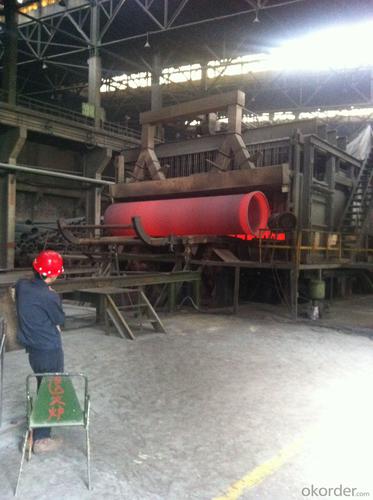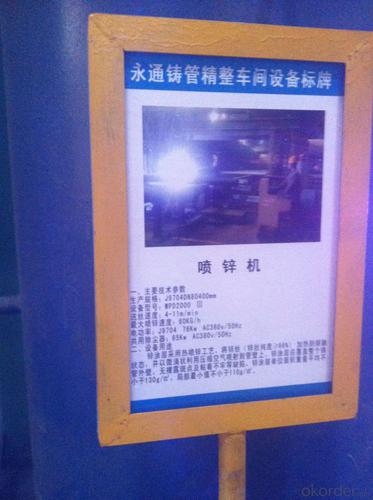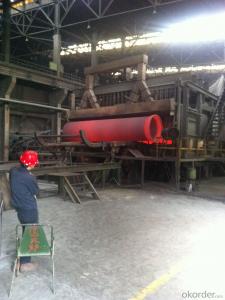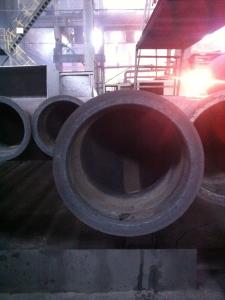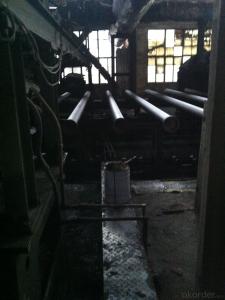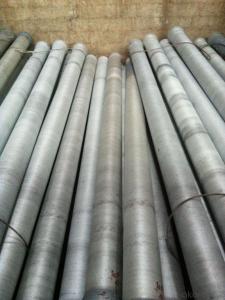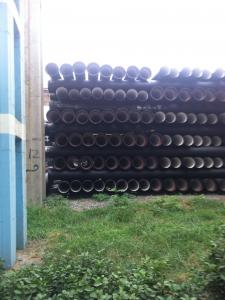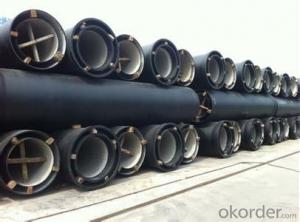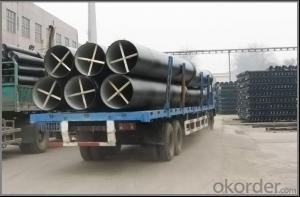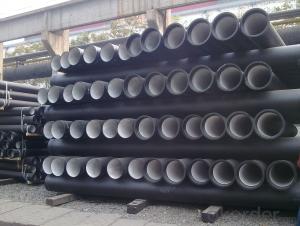DUCTILE IRON PIPES AND PIPE FITTINGS K9 CLASS DN600
- Loading Port:
- Tianjin
- Payment Terms:
- TT OR LC
- Min Order Qty:
- 22 pc
- Supply Capability:
- 3000 pc/month
OKorder Service Pledge
OKorder Financial Service
You Might Also Like
Material : Ductile Cast Iron
Size Range : DN 80mm to DN 2000mm
Unit Effective Length : 6m or 5.7m
Manufacture Standard: ISO 2531:1998/ EN 545:2006/EN 598:2007
Annual capacity : 200,000 tons
Coating Exterior: Zinc 130g/m2 according to ISO 8179-1 and bitumen coating 70 microns.
Cement Interior: Portland Cement/ High Alumina Cement/ Sulphate Resisting Cement Lining according to ISO 4179
Special requirements on external coating and internal lining can be applied
We also provide accessories such as SBR/EPDM rubber gaskets, lubricant paste, pipe caps, PE sleeves, etc.
Additional Parts:
Each pipe is strictly inspected according to related standard to ensure permanently high performance.
Easy Installation at site and service free for life
Long Service Lifespan
Quotation will arrive you within 24hours once we get your inquiry.
We guarantee offering you a competitive price.
A copy of original inspection reports of pipes will be offered after shipment.
Photos of loading process will be sent to the customer after shipment effect.
We will follow-up the delivery progress after shipment effect and update to the customer on weekly basis.
- Q: Are ductile iron pipes prone to external corrosion?
- Yes, ductile iron pipes are prone to external corrosion.
- Q: How does ductile iron pipe perform in seismic conditions?
- Seismic conditions are where ductile iron pipe truly shines. This type of pipe has gained a reputation for its outstanding performance in such situations, making it the go-to choice for underground water and wastewater systems, particularly in earthquake-prone areas. The remarkable strength and flexibility of ductile iron pipe make it highly resistant to seismic forces. It can withstand the ground movements and vibrations caused by earthquakes without suffering significant damage or failure. The secret lies in its unique composition, which consists of a high iron content combined with small amounts of carbon and other alloying elements. The crucial advantage of ductile iron pipe in seismic conditions is its ability to absorb and dissipate seismic energy through its inherent flexibility. When the ground shifts during an earthquake, the pipe can adapt and deform slightly to accommodate the movement. This minimizes stress concentrations and reduces the risk of fractures. Furthermore, the joint integrity of ductile iron pipe is exceptional, a vital characteristic in seismic conditions. The joints are designed to offer maximum strength and resistance against external forces, including seismic activity. Different joint types, such as push-on, mechanical, and restrained joints, are available to suit various seismic requirements and installation conditions. Not only does ductile iron pipe possess impressive mechanical properties, but it also offers long-term corrosion resistance. Typically, the pipe is lined with a cement mortar or a protective coating, acting as a barrier against corrosive elements present in the soil or water. This corrosion resistance ensures the pipe's structural integrity and longevity, even in regions with high seismic activity. Overall, ductile iron pipe has a proven track record of exceptional performance in seismic conditions. Its strength, flexibility, joint integrity, and corrosion resistance make it a reliable choice for underground infrastructure, providing secure and efficient water and wastewater systems in areas prone to earthquakes.
- Q: How does ductile iron pipe perform in areas with high traffic loads?
- Ductile iron pipe performs exceptionally well in areas with high traffic loads. Its high strength and durability make it capable of withstanding heavy loads and traffic without any significant deformation or damage.
- Q: Do ductile iron pipes require special handling during transportation?
- Yes, ductile iron pipes do require special handling during transportation. They are heavy and brittle, so they need to be loaded and unloaded carefully to prevent damage. Additionally, they should be properly secured and supported to avoid any bending or distortion during transit.
- Q: Can ductile iron pipes be used in areas with high levels of hydrogen sulfide gas and corrosion potential?
- Before making a decision, it is important to take certain factors into consideration when considering the use of ductile iron pipes in areas with high levels of hydrogen sulfide gas and corrosion potential. Ductile iron pipes display a strong resistance to corrosion, particularly when they are adequately protected with external coatings and linings. This characteristic makes them appropriate for environments with moderate levels of hydrogen sulfide gas and corrosion potential. Nevertheless, in areas with exceedingly high levels of hydrogen sulfide gas and severe corrosion potential, alternative materials such as corrosion-resistant alloys or specially coated pipes may be more suitable. To determine the suitability of ductile iron pipes, conducting a thorough evaluation of the specific conditions in the area is crucial. Factors such as the concentration of hydrogen sulfide gas, the presence of other corrosive elements or chemicals, and the overall corrosiveness of the environment should be taken into account. Furthermore, consulting the local regulations and industry standards is essential to ensure compliance and safety. In conclusion, while ductile iron pipes can withstand moderate levels of hydrogen sulfide gas and corrosion potential, it is necessary to conduct a comprehensive assessment of the specific conditions. In areas with high levels of hydrogen sulfide gas and severe corrosion potential, consulting with experts in the field and considering alternative materials may be required.
- Q: How is ductile iron pipe tested for quality?
- Extensive quality testing is carried out on ductile iron pipe to ensure its performance and reliability in various applications. The pipe undergoes a series of steps to assess its physical and mechanical properties. The hydrostatic pressure test is one of the main tests performed on ductile iron pipe. This test involves subjecting the pipe to fluid pressure that exceeds its designed operating pressure. The purpose is to determine if the pipe can withstand internal pressure without any leakage or failure. The pipe is filled with water or another suitable fluid, and the pressure is gradually increased to the required level. During this test, the pipe is carefully inspected for any signs of leakage or deformation. Another essential test is the tensile strength test, which measures the pipe's ability to resist pulling or stretching forces. A sample of the pipe is pulled until it breaks, and the maximum force applied during the test is recorded. This test helps determine important properties such as the pipe's ultimate tensile strength, yield strength, and elongation. The Charpy test is used to assess the pipe's impact resistance. In this test, a notched sample is struck with a swinging pendulum to measure the amount of energy absorbed by the pipe. It helps determine if the pipe can withstand sudden impacts or loads without fracturing. In addition to these tests, the pipe also undergoes various non-destructive tests, including ultrasonic testing, magnetic particle inspection, and visual inspection. These tests are crucial in detecting any internal or external defects, cracks, or abnormalities that could compromise the pipe's structural integrity. Furthermore, chemical analysis and metallographic examination are performed to evaluate the chemical composition and microstructure of the ductile iron pipe. These tests ensure that the pipe meets the necessary specifications and standards for its intended application. Overall, the testing process for ductile iron pipe is thorough and stringent. Its purpose is to guarantee the pipe's quality, durability, and overall performance in safely and efficiently delivering water, wastewater, or other fluids.
- Q: Water supply pipe is ductile iron, then it's fittings and valves and other parts must be ductile iron?
- Ductile iron pipe end rubber ring interface should belong to flexible connection. It should be the way to connect the clamps. Then, the valve is also connected to the card sleeve connection.
- Q: What is the expected bending stress capacity of ductile iron pipes?
- Ductile iron pipes exhibit varying expected bending stress capacities due to factors such as diameter, wall thickness, and the grade of ductile iron utilized. However, in general, ductile iron pipes possess superior bending stress capacities compared to alternative pipe materials. Ductile iron pipes are renowned for their remarkable tensile strength and flexibility, enabling them to endure substantial bending stresses. Determining the precise bending stress capacity involves comprehensive testing and analysis, taking into account the pipe's mechanical properties, dimensions, and maximum allowable deflection. It is crucial to evaluate the bending stress capacity of ductile iron pipes in accordance with established industry standards and guidelines. These may involve standards like the American Water Works Association (AWWA) C150 or the International Organization for Standardization (ISO) 2531, which outline specifications and testing methodologies for ductile iron pipes. Ultimately, the anticipated bending stress capacity of ductile iron pipes hinges upon various factors and necessitates an assessment tailored to the specific application requirements. It must consider industry standards and guidelines to ensure precise and dependable results.
- Q: Can ductile iron pipes be used for underground cable conduits?
- Yes, ductile iron pipes can be used for underground cable conduits. Ductile iron pipes are known for their strength, durability, and resistance to corrosion, making them suitable for various applications including underground cable conduits. They have the ability to handle heavy loads and provide protection to the cables from external elements. Additionally, ductile iron pipes have a long lifespan, reducing the need for frequent replacements and maintenance. However, it is important to consider factors such as depth of burial, soil conditions, and specific requirements of the cable installation before choosing ductile iron pipes for underground cable conduits.
- Q: How are ductile iron pipes protected against stray current corrosion?
- Various preventive measures and protective coatings are employed to safeguard ductile iron pipes from stray current corrosion. Stray current corrosion arises when an electric current flows through the pipe, causing accelerated corrosion and potential harm. To prevent this, the following measures are generally utilized: 1. Electrical isolation: Ductile iron pipes are insulated from other metallic structures by means of insulating materials like rubber gaskets or non-conductive coatings. This insulation obstructs the passage of stray current through the pipe, thereby minimizing the risk of corrosion. 2. Cathodic protection: Cathodic protection is a widely employed technique to shield ductile iron pipes from stray current corrosion. It involves installing sacrificial anodes or impressed current systems near the pipe. These anodes or systems emit a controlled electric current that counters the stray current and guarantees the cathodic protection of the iron pipe. 3. Coatings: Ductile iron pipes are typically coated with protective layers to enhance their resistance against corrosion. A common coating is fusion-bonded epoxy (FBE), which offers a high level of protection against stray current corrosion. FBE coatings act as a barrier, preventing electrical contact between the pipe and the surrounding environment. 4. Monitoring and maintenance: Regular monitoring and maintenance are essential for ensuring the ongoing protection of ductile iron pipes against stray current corrosion. This entails inspecting the protective coatings for any damage or deterioration and promptly repairing or replacing them as required. Additionally, monitoring systems can be installed to detect and measure stray currents, allowing for timely intervention if necessary. By implementing these protection measures, ductile iron pipes can effectively ward off stray current corrosion, thereby prolonging their lifespan and ensuring the integrity of the pipeline infrastructure.
Send your message to us
DUCTILE IRON PIPES AND PIPE FITTINGS K9 CLASS DN600
- Loading Port:
- Tianjin
- Payment Terms:
- TT OR LC
- Min Order Qty:
- 22 pc
- Supply Capability:
- 3000 pc/month
OKorder Service Pledge
OKorder Financial Service
Similar products
Hot products
Hot Searches
Related keywords


